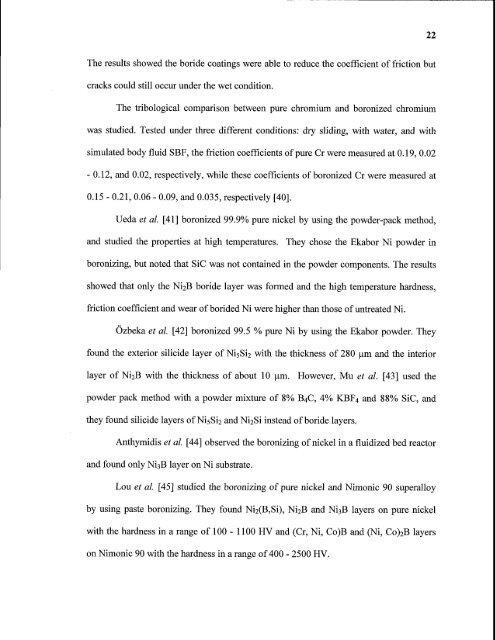Multi-component boron coatings on low carbon steel AISI 1018
Multi-component boron coatings on low carbon steel AISI 1018
Multi-component boron coatings on low carbon steel AISI 1018
You also want an ePaper? Increase the reach of your titles
YUMPU automatically turns print PDFs into web optimized ePapers that Google loves.
22<br />
The results showed the boride <str<strong>on</strong>g>coatings</str<strong>on</strong>g> were able to reduce the coefficient of fricti<strong>on</strong> but<br />
cracks could still occur under the wet c<strong>on</strong>diti<strong>on</strong>.<br />
The tribological comparis<strong>on</strong> between pure chromium and <str<strong>on</strong>g>bor<strong>on</strong></str<strong>on</strong>g>ized chromium<br />
was studied. Tested under three different c<strong>on</strong>diti<strong>on</strong>s: dry sliding, with water, and with<br />
simulated body fluid SBF, the fricti<strong>on</strong> coefficients of pure Cr were measured at 0.19, 0.02<br />
- 0.12, and 0.02, respectively, while these coefficients of <str<strong>on</strong>g>bor<strong>on</strong></str<strong>on</strong>g>ized Cr were measured at<br />
0.15 - 0.21, 0.06 - 0.09, and 0.035, respectively [40].<br />
Ueda et al. [41] <str<strong>on</strong>g>bor<strong>on</strong></str<strong>on</strong>g>ized 99.9% pure nickel by using the powder-pack method,<br />
and studied the properties at high temperatures. They chose the Ekabor Ni powder in<br />
<str<strong>on</strong>g>bor<strong>on</strong></str<strong>on</strong>g>izing, but noted that SiC was not c<strong>on</strong>tained in the powder <str<strong>on</strong>g>comp<strong>on</strong>ent</str<strong>on</strong>g>s. The results<br />
showed that <strong>on</strong>ly the Ni2B boride layer was formed and the high temperature hardness,<br />
fricti<strong>on</strong> coefficient and wear of borided Ni were higher than those of untreated Ni.<br />
Ozbeka et al. [42] <str<strong>on</strong>g>bor<strong>on</strong></str<strong>on</strong>g>ized 99.5 % pure Ni by using the Ekabor powder. They<br />
found the exterior silicide layer of Ni 5Si2 with the thickness of 280 µm and the interior<br />
layer of Ni2B with the thickness of about 10 µm. However, Mu et al. [43] used the<br />
powder pack method with a powder mixture of 8% B4C, 4% KBF 4 and 88% SiC, and<br />
they found silicide layers of Ni5Si2 and Ni2Si instead of boride layers.<br />
Anthymidis et al. [44] observed the <str<strong>on</strong>g>bor<strong>on</strong></str<strong>on</strong>g>izing of nickel in a fluidized bed reactor<br />
and found <strong>on</strong>ly Ni3B layer <strong>on</strong> Ni substrate.<br />
Lou et al. [45] studied the <str<strong>on</strong>g>bor<strong>on</strong></str<strong>on</strong>g>izing of pure nickel and Nim<strong>on</strong>ic 90 superalloy<br />
by using paste <str<strong>on</strong>g>bor<strong>on</strong></str<strong>on</strong>g>izing. They found Ni2(B,Si), Ni 2B and Ni3B layers <strong>on</strong> pure nickel<br />
with the hardness in a range of 100 - 1100 HV and (Cr, Ni, Co)B and (Ni, Co)2B layers<br />
<strong>on</strong> Nim<strong>on</strong>ic 90 with the hardness in a range of 400 - 2500 HV.
















